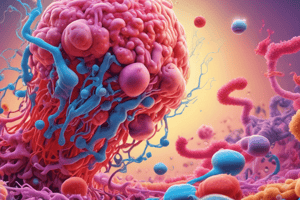Podcast
Questions and Answers
How do pathogenic bacteria primarily differ from non-pathogenic bacteria?
How do pathogenic bacteria primarily differ from non-pathogenic bacteria?
- They are often found in soil and water environments.
- They possess the ability to cause disease. (correct)
- They contribute to the normal flora of the human body.
- They are essential for producing antibiotics.
In what way does the pathogenicity among different bacteria commonly vary?
In what way does the pathogenicity among different bacteria commonly vary?
- All pathogenic bacteria exhibit the same level of disease-causing ability.
- It remains constant regardless of the environmental conditions.
- It varies depending on the bacterial species or strain. (correct)
- It solely depends on the host's immune response.
Where can non-pathogenic bacteria typically be found?
Where can non-pathogenic bacteria typically be found?
- Only in laboratory settings.
- In soil, water, and as normal flora in the human body. (correct)
- Primarily in diseased tissues.
- Exclusively in sterile environments.
What role do certain Streptomyces species play in biotechnology?
What role do certain Streptomyces species play in biotechnology?
What distinguishes endospore-forming bacteria from non-endospore-forming bacteria?
What distinguishes endospore-forming bacteria from non-endospore-forming bacteria?
What primary attribute characterizes bacterial endospores?
What primary attribute characterizes bacterial endospores?
How does the dormancy of endospores contribute to the survival of bacteria?
How does the dormancy of endospores contribute to the survival of bacteria?
What is the 'vegetative cell' in the context of spore-forming bacteria?
What is the 'vegetative cell' in the context of spore-forming bacteria?
Which key factor determines the classification of bacteria into endospore-forming or non-endospore-forming groups?
Which key factor determines the classification of bacteria into endospore-forming or non-endospore-forming groups?
Which of the following exemplifies a bacterium known for its ability to form endospores?
Which of the following exemplifies a bacterium known for its ability to form endospores?
What is the primary role of macronutrients in microbial growth?
What is the primary role of macronutrients in microbial growth?
Which set of elements constitutes the highest percentage of a cell's dry weight?
Which set of elements constitutes the highest percentage of a cell's dry weight?
What characterizes the function of trace elements in microorganisms?
What characterizes the function of trace elements in microorganisms?
What is the significance of vitamins in microbial nutrition?
What is the significance of vitamins in microbial nutrition?
What role do purines and pyrimidines play in microbial growth?
What role do purines and pyrimidines play in microbial growth?
Under which classification do temperature, oxygen, and pH primarily fall regarding microbial growth requirements?
Under which classification do temperature, oxygen, and pH primarily fall regarding microbial growth requirements?
How does osmotic pressure affect microbial growth?
How does osmotic pressure affect microbial growth?
If a bacterium is described as 'commensal,' what does this indicate about its relationship with a host organism?
If a bacterium is described as 'commensal,' what does this indicate about its relationship with a host organism?
Which environmental factor can significantly affect the germination process of bacterial spores?
Which environmental factor can significantly affect the germination process of bacterial spores?
Within which classification do bacteria used in the production of yogurt, such as Lactobacillus, belong?
Within which classification do bacteria used in the production of yogurt, such as Lactobacillus, belong?
Why is it crucial to understand the nutritional requirements of bacteria in biotechnology?
Why is it crucial to understand the nutritional requirements of bacteria in biotechnology?
How does knowledge of bacterial pathogenicity aid in medical and health sciences?
How does knowledge of bacterial pathogenicity aid in medical and health sciences?
In the process of sporulation, what occurs after a cell's chromosome is duplicated and separated?
In the process of sporulation, what occurs after a cell's chromosome is duplicated and separated?
During sporulation, what is the role of the sporangium?
During sporulation, what is the role of the sporangium?
What leads to the release of a free spore from a bacterial cell?
What leads to the release of a free spore from a bacterial cell?
What causes a spore to swell and release a vegetative cell during germination?
What causes a spore to swell and release a vegetative cell during germination?
How does understanding bacterial classification based on spore formation impact industrial processes?
How does understanding bacterial classification based on spore formation impact industrial processes?
Why do microorganisms require elements such as carbon, oxygen, and nitrogen in large quantities?
Why do microorganisms require elements such as carbon, oxygen, and nitrogen in large quantities?
What common characteristic do copper, molybdenum, and zinc share concerning their role in microbial cells?
What common characteristic do copper, molybdenum, and zinc share concerning their role in microbial cells?
Which role is specifically attributed to amino acids in the context of microbial growth and nutrition?
Which role is specifically attributed to amino acids in the context of microbial growth and nutrition?
How do classifications of bacteria, based on factors like spore formation and pathogenicity, influence public health practices?
How do classifications of bacteria, based on factors like spore formation and pathogenicity, influence public health practices?
Which statement accurately represents the relationship between normal flora and pathogenicity in bacteria?
Which statement accurately represents the relationship between normal flora and pathogenicity in bacteria?
What is the significance of trace elements like copper, molybdenum, and zinc for bacterial enzymes?
What is the significance of trace elements like copper, molybdenum, and zinc for bacterial enzymes?
Why is the resistance of bacterial endospores to antimicrobial agents a significant concern in healthcare and industrial settings?
Why is the resistance of bacterial endospores to antimicrobial agents a significant concern in healthcare and industrial settings?
How can understanding the nutritional requirements of bacteria be useful in developing new antimicrobial strategies?
How can understanding the nutritional requirements of bacteria be useful in developing new antimicrobial strategies?
Considering the role of oxygen as an environmental requirement for microbial growth, what implications does this have for culturing anaerobic bacteria?
Considering the role of oxygen as an environmental requirement for microbial growth, what implications does this have for culturing anaerobic bacteria?
What is the primary function of the cortex layer in a mature bacterial endospore?
What is the primary function of the cortex layer in a mature bacterial endospore?
Flashcards
Pathogenic bacteria
Pathogenic bacteria
Able to cause disease.
Non-pathogenic bacteria
Non-pathogenic bacteria
Do not cause disease and may be beneficial.
Endospore
Endospore
A specialized, dormant form of bacterial cell that is highly resistant to adverse conditions.
Endospore-forming bacteria
Endospore-forming bacteria
Signup and view all the flashcards
Non-endospore forming bacteria
Non-endospore forming bacteria
Signup and view all the flashcards
Macronutrients
Macronutrients
Signup and view all the flashcards
Trace elements
Trace elements
Signup and view all the flashcards
Growth factors
Growth factors
Signup and view all the flashcards
Germination
Germination
Signup and view all the flashcards
Microbial Environmental Needs
Microbial Environmental Needs
Signup and view all the flashcards
Study Notes
- General Microbiology is course HST 110.
- Lecture 3 covers the classification of bacteria and their nutritional needs.
Learning Outcomes
- Understanding the differences between pathogenic and non-pathogenic bacteria is a key outcome.
- Another key outcome is understanding the differences between spore-forming and non-spore-forming bacteria.
- Identifying the different nutritional requirements for bacteria is also a learning objective.
Classifications of Bacteria According to Pathogenicity
- Pathogenic bacteria can cause disease.
- The degree of pathogenicity varies from one bacterium to another.
- Non-pathogenic bacteria do not cause disease.
- Normal flora or commensal bacteria are non-pathogenic.
- Non-pathogenic bacteria are present naturally in the human body, such as on the skin, in the mouth, stomach, and intestines.
- They are also present in the environment, for example, in soil, seawater, and rivers.
- Some non-pathogenic bacteria are used in biotechnology.
Streptomyces griseusfrom soil is used to produce Streptomycin (an antibiotic).Lactobacillusis used to produce yoghurt.
Classifications of Bacteria According to Spore Formation
- An endospore is a specialized form of bacterial cell, allowing the bacteria to resist unfavorable conditions of growth.
- Endospores can remain dormant for perhaps 100 years, or even longer.
- Structures are highly resistant to antimicrobial agents and sterilization.
- Endospores can germinate to become a multiplying cell, called a vegetative cell.
- Bacteria are classified by spore formation.
- Bacillus bacteria often form endospores.
Bacillus anthracisis an example of a bacteria that forms endospores.
Microbial Growth Requirements
- Nutritional requirements of bacteria include macronutrients, trace elements, and growth factors.
- Environmental requirements include temperature, pH, oxygen and osmotic pressure (salt concentration).
Nutritional Requirements
- Microorganisms require about ten elements in large quantities.
- Macronutrients are used to construct carbohydrates, lipids, proteins, and nucleic acids.
- Macronutrients constitute 95% or more of cell dry weight.
- Macronutrients include carbon, oxygen, nitrogen, sulfur, phosphorus, hydrogen, potassium, calcium, magnesium, and iron.
- Trace elements are needed in very small amounts acting as parts of enzymes and cofactors.
- Mineral elements like copper, molybdenum, and zinc are trace elements.
- Amino acids are needed for protein synthesis and are considered growth factors.
- Purines and pyrimidines needed for nucleic acid synthesis and are considered growth factors.
- Vitamins are considered growth factors that make up all or part of enzyme cofactors.
Summary
- Not all bacteria are pathogenic; some are useful and part of normal flora or are commensal.
- Not all bacteria form spores; mostly bacillus form spores.
- Nutritional growth requirements include macronutrients, growth factors, and trace elements.
Lecture 3 Exercises
StreptomycesandYoghurtare examples of the useful use of microorganisms in biotechnology.Bacillus anthracisis an example of bacteria that form spores.- Carbon and nitrogen are examples of macronutrient.
- Amino acids are examples of growth factors.
Studying That Suits You
Use AI to generate personalized quizzes and flashcards to suit your learning preferences.





